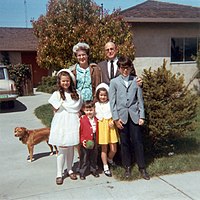Vernacular photography

Vernacular photography [1] is the creation of photographs, usually by amateur or unknown photographers both professional and amateur, who take everyday life and common things as subjects. Though the more commonly known definition of the word "vernacular" is a quality of being "indigenous" or "native," the use of the word in relation to art and architecture refers more to the meaning of the following sub-definition (of vernacular architecture) from The Oxford English Dictionary: "concerned with ordinary domestic and functional buildings rather than the essentially monumental." Examples of vernacular photographs include travel and vacation photos, family snapshots, photos of friends, class portraits, identification photographs, and photo-booth images. Vernacular photographs are types of accidental art, in that they often are unintentionally artistic.[2]
Closely related to vernacular photography is found photography, which in one sense refers to the recovery of a lost, unclaimed, or discarded vernacular photograph or snapshot. Found photos are often found at flea markets, thrift and other secondhand stores, yard sales, estate and tag sales, in dumpsters and trash cans, between the pages of books, or literally just "found" anywhere.
The use of vernacular photography in the arts is almost as old as photography itself. Vernacular photography has become far more commonplace in recent years as an art technique and is now a widely accepted genre of art photography. This form of photography began to develop in the years leading up to World War II.[3][4]
Vernacular photographs also have become popular with art collectors and with collectors of found photographs. Some curators have begun to exhibit vernacular photography.[5] Though collections of vernacular photography typically consist of found physical photographs from bygone eras, some collectors have expanded their definition to include digitally sourced photographs, such as the amateur product photography used for online classifieds listings.[6]
Walker Evans is attributed with being heavily influenced by this style of photography.[7]
References
- ^ "Vernacular Photography". Retrieved 2013-03-31.
- ^ Szarkowski, John. "INTERVIEW: "Eyes Wide Open: Interview with John Szarkowski" (2006)". Retrieved 30 March 2013.
- ^ Ennis, Helen (March 2011). "Death and Digital Photography". Cultural Studies Review. 17 (1): 132.
- ^ Zuromskis, Catherine (2008). "Catherine Zuromskis. "Outside Art: Exhibiting Snapshot Photography."". American Quarterly. 60 (2): 425-441.
- ^ Longmire, Stephen. "Back West: Reviewing American Landscape Photography". Retrieved 31 March 2013.
- ^ "Strange & Wornderful Vernacular Photography". Significant Objects. Retrieved 27 July 2014.
- ^ Tormey, Jane. "WALKER EVANS: "Walker Evans's 'Counter-Aesthetic'" (2003)". Retrieved 30 March 2013.
